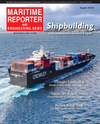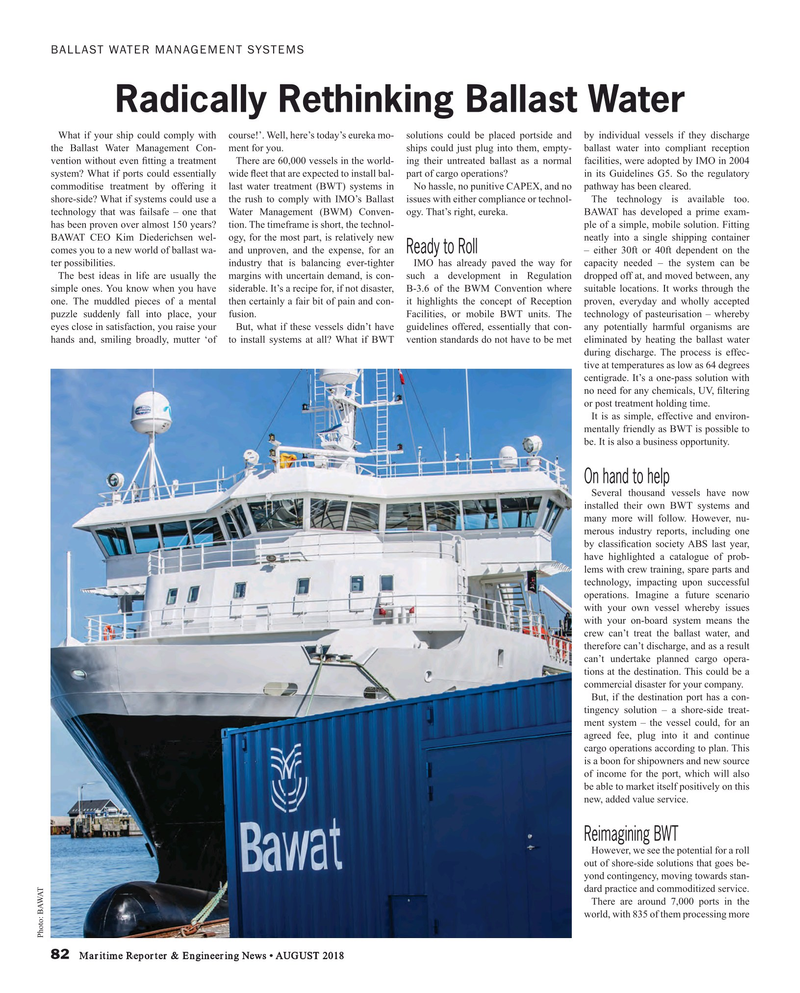
Page 82: of Maritime Reporter Magazine (August 2018)
The Shipyard Edition
Read this page in Pdf, Flash or Html5 edition of August 2018 Maritime Reporter Magazine
BALLAST WATER MANAGEMENT SYSTEMS
Radically Rethinking Ballast Water
What if your ship could comply with course!’. Well, here’s today’s eureka mo- solutions could be placed portside and by individual vessels if they discharge the Ballast Water Management Con- ment for you. ships could just plug into them, empty- ballast water into compliant reception vention without even ? tting a treatment There are 60,000 vessels in the world- ing their untreated ballast as a normal facilities, were adopted by IMO in 2004 system? What if ports could essentially wide ? eet that are expected to install bal- part of cargo operations? in its Guidelines G5. So the regulatory commoditise treatment by offering it last water treatment (BWT) systems in No hassle, no punitive CAPEX, and no pathway has been cleared.
shore-side? What if systems could use a the rush to comply with IMO’s Ballast issues with either compliance or technol- The technology is available too. technology that was failsafe – one that Water Management (BWM) Conven- ogy. That’s right, eureka. BAWAT has developed a prime exam- has been proven over almost 150 years? tion. The timeframe is short, the technol- ple of a simple, mobile solution. Fitting
BAWAT CEO Kim Diederichsen wel- ogy, for the most part, is relatively new neatly into a single shipping container comes you to a new world of ballast wa- and unproven, and the expense, for an – either 30ft or 40ft dependent on the Ready to Roll ter possibilities. industry that is balancing ever-tighter IMO has already paved the way for capacity needed – the system can be
The best ideas in life are usually the margins with uncertain demand, is con- such a development in Regulation dropped off at, and moved between, any simple ones. You know when you have siderable. It’s a recipe for, if not disaster, B-3.6 of the BWM Convention where suitable locations. It works through the one. The muddled pieces of a mental then certainly a fair bit of pain and con- it highlights the concept of Reception proven, everyday and wholly accepted puzzle suddenly fall into place, your fusion. Facilities, or mobile BWT units. The technology of pasteurisation – whereby eyes close in satisfaction, you raise your But, what if these vessels didn’t have guidelines offered, essentially that con- any potentially harmful organisms are hands and, smiling broadly, mutter ‘of to install systems at all? What if BWT vention standards do not have to be met eliminated by heating the ballast water during discharge. The process is effec- tive at temperatures as low as 64 degrees centigrade. It’s a one-pass solution with no need for any chemicals, UV, ? ltering or post treatment holding time.
It is as simple, effective and environ- mentally friendly as BWT is possible to be. It is also a business opportunity.
On hand to help
Several thousand vessels have now installed their own BWT systems and many more will follow. However, nu- merous industry reports, including one by classi? cation society ABS last year, have highlighted a catalogue of prob- lems with crew training, spare parts and technology, impacting upon successful operations. Imagine a future scenario with your own vessel whereby issues with your on-board system means the crew can’t treat the ballast water, and therefore can’t discharge, and as a result can’t undertake planned cargo opera- tions at the destination. This could be a commercial disaster for your company.
But, if the destination port has a con- tingency solution – a shore-side treat- ment system – the vessel could, for an agreed fee, plug into it and continue cargo operations according to plan. This is a boon for shipowners and new source of income for the port, which will also be able to market itself positively on this new, added value service.
Reimagining BWT
However, we see the potential for a roll out of shore-side solutions that goes be- yond contingency, moving towards stan- dard practice and commoditized service.
There are around 7,000 ports in the world, with 835 of them processing more
Photo: BAWAT 82 Maritime Reporter & Engineering News • AUGUST 2018
MR #8 (82-89).indd 82 MR #8 (82-89).indd 82 8/7/2018 10:10:22 AM8/7/2018 10:10:22 AM

 81
81

 83
83
